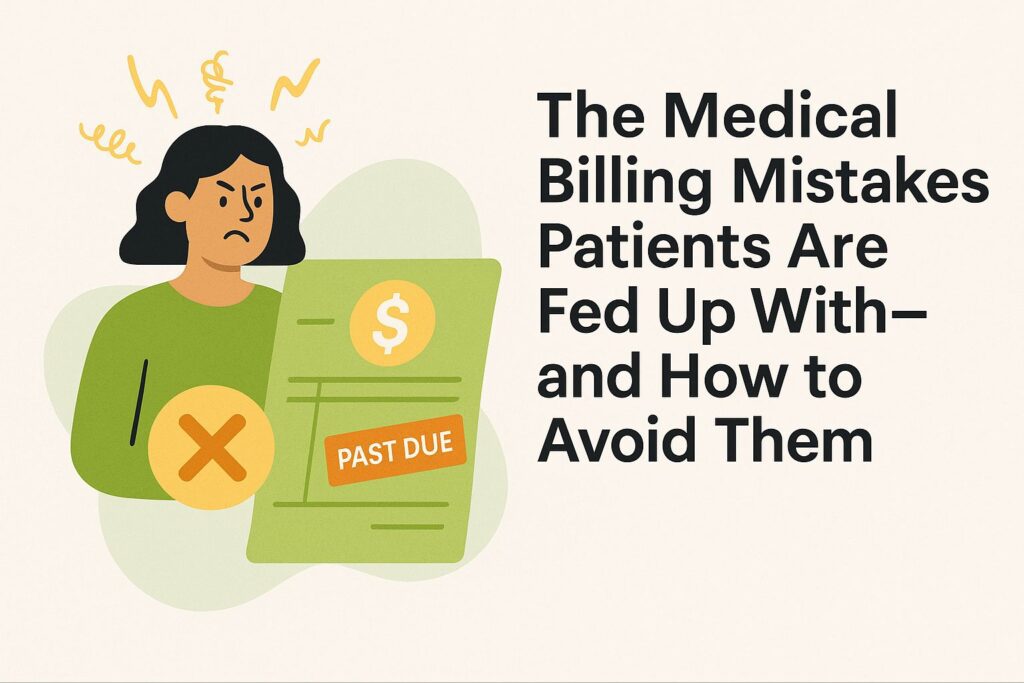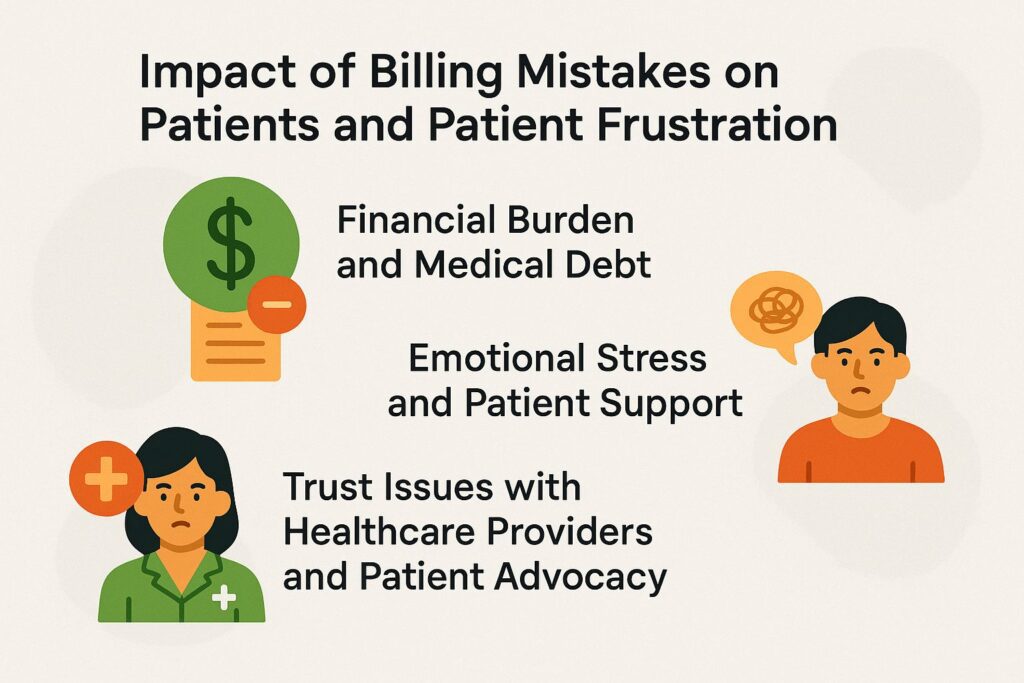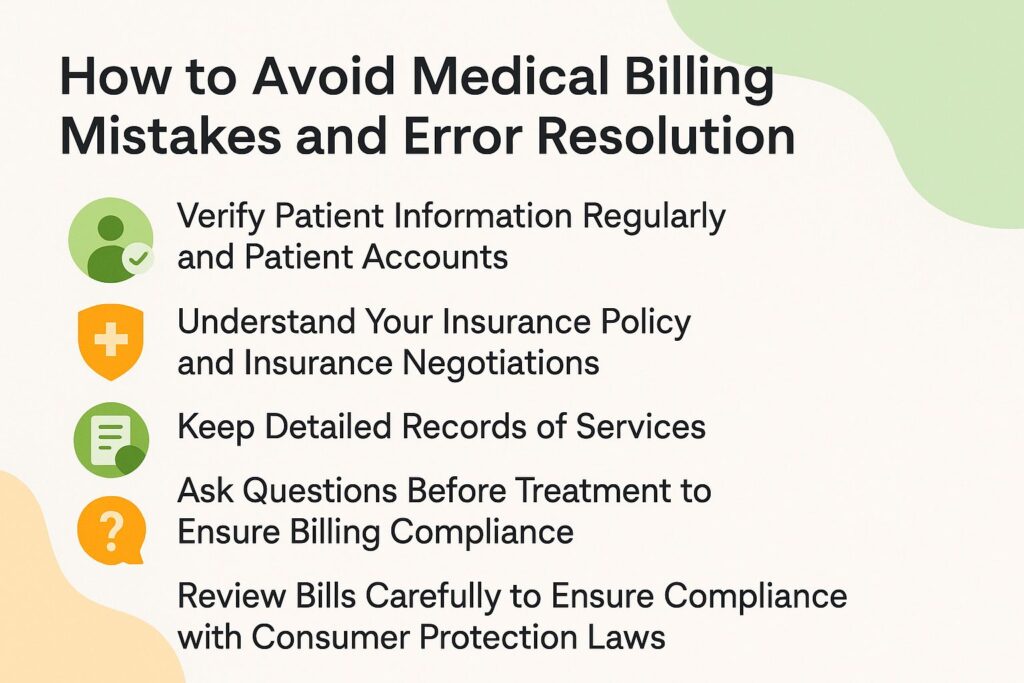
The Medical Billing Mistakes Patients Are Fed Up With—and How to Avoid Them
You go to the doctor, expecting care, not confusion. Yet, countless patients face frustrating billing blunders that lead to unexpected costs and stress. Knowing these usual errors-such as wrong details and charging for services not provided-can help you manage things better. This article explains the common problems patients face with medical billing, how they affect them, and practical steps you can use to prevent expensive unexpected events. Let's clear the confusion together!
Overview of Medical Billing and Billing Procedures
Medical billing is the process through which healthcare providers receive payment for services rendered, involving complex interactions with insurers and patients, including claim submissions and coding errors (our guide on common billing issues explores these complexities).
In this system, providers log the services they offer and submit claims to insurance companies for resolving healthcare billing issues to receive reimbursement. Insurers then review the claims for accuracy and determine the amount covered, communicating this to both the provider and the patient.
Patients may be responsible for deductibles or copayments, adding another layer to the billing process. Clear communication and keeping accurate records help make sure payments are on time and avoid arguments. Everyone should understand the billing schedule.
Why It's Important to Know Billing and Healthcare Costs
Knowing how medical billing works allows patients to handle their financial responsibilities and avoid costly errors.
Knowing about medical billing helps patients avoid denied claims and surprise bills. Start by familiarizing yourself with your insurance policy, including co-pays, deductibles, and out-of-pocket maximums to understand billing transparency initiatives.
Use tools like MyChart or your insurance provider's app to check bills and claim updates. When a bill arrives, verify that the services listed match your treatment. If discrepancies occur, contact your healthcare provider or insurer immediately to clarify charges.
This active method simplifies billing and helps patients manage their healthcare expenses.
Common Medical Billing Mistakes

Errors in medical billing can cause big problems, like late payments and more upset patients. Related insight: From Duplicate Charges to Coding Errors: The Billing Issues Patients Hate Most explores these common pitfalls in detail.
Incorrect Patient Information and Demographic Information
Incorrect patient information, including demographic information, is a leading cause of billing errors, potentially resulting in claim denials and delays in reimbursement.
To solve this problem, we need to set up a way to check information. Start by implementing a checklist for staff to confirm key details:
- Patient names must be spelled correctly.
- Dates of birth should be double-checked.
- Insurance details need to match policy documents.
Use tools like electronic health record (EHR) systems that allow checking patient information instantly. Hold frequent training sessions for staff to stress the need for accuracy. By encouraging careful work practices, healthcare providers can greatly lower billing mistakes and improve how smoothly revenue cycles operate.
Billing for Non-Rendered Services and Overbilling
Billing for services not provided can lead to patient disputes and damage trust in healthcare providers.
To avoid billing errors, implement a confirmation system that verifies service delivery before charges are processed. This might involve emailing patients a detailed list of the services they received and asking them to confirm they got it.
Use tools like patient management software (e.g., SimplePractice or Practice Fusion) that help track provided services and send alerts. Training staff regularly on correct billing methods helps avoid confusion, promotes clear communication with patients, and maintains provider honesty. This approach aligns with the principles outlined in our analysis of common billing issues that frustrate patients.
Mistakes People Make with Insurance Coverage and Policies
Many patients face billing surprises due to a lack of clarity about their insurance coverage and insurance terms, leading to unexpected out-of-pocket costs.
To prevent unexpected costs, patients should carefully read their insurance policies before getting treatment.
Use resources from the Insurance Information Institute to explain deductibles and co-pays. Tools like the billing department in a healthcare provider's office can also provide information about patient expenses.
Requesting a pre-authorization can help patients understand potential expenses upfront. This proactive approach allows patients to make informed decisions about their healthcare, leading to better financial outcomes.
Duplicate Billing Issues and Administrative Errors
Duplicate billing can create unnecessary financial burdens for patients, potentially resulting in overpayments and claims confusion.
To stop duplicate billing and administrative costs, regularly check billing procedures.
- Start by tracking all invoices issued and payments received each month. Use software like QuickBooks or FreshBooks to keep records correctly.
- Make a plan to review your bills every three months and look for mistakes or charges that show up more than once.
- Train staff to recognize common red flags, such as multiple charges for the same service within a short time frame.
By implementing these measures, you'll maintain transparency in billing and reduce the risk of costly errors.
Incorrect Code Usage and Service Codes
Using incorrect medical codes can lead to significant reimbursement issues and billing errors, affecting both providers and patients.
To mitigate these risks, it's critical to implement ongoing training for billing departments. Staff should be familiar with the latest coding updates and compliance standards, utilizing resources like the American Academy of Professional Coders (AAPC) for certifications.
Using coding software like Optum360 can improve accuracy by offering coding help immediately. Regular checks should be done to find and fix errors, ensuring the billing process complies with healthcare rules and industry standards.
Impact of Billing Mistakes on Patients and Patient Frustration

Billing errors can greatly impact patients, causing money problems, stress, and trust issues. For a deeper understanding of the specific billing issues patients find most frustrating, such as duplicate charges and coding errors, consider reading our elaborate discussion on common billing challenges.
Financial Burden and Medical Debt
Patients often face unexpected financial burdens due to billing errors, potentially impacting their ability to afford necessary care.
Billing mistakes can lead to increased out-of-pocket expenses by generating extra charges for services not rendered or incorrect co-payments. To mitigate these issues, patients should take proactive steps.
- Always verify your bills against the explanation of benefits (EOB) provided by your insurance.
- Use tools like Mint or Personal Capital to help you create a budget that accounts for potential discrepancies in healthcare costs.
- Keep detailed records of all medical transactions, which can be very helpful if you need to dispute charges.
- Check your statements often to find mistakes quickly and keep your finances safe.
Emotional Stress and Patient Support
Errors in billing can create stress and frustration, complicating the relationship between patients and healthcare providers.
This emotional burden impacts the patient's mental health and can cause them to lose trust in healthcare providers.
To alleviate these feelings, patients should consider strategies such as keeping a detailed log of communications regarding billing, which can help clarify disputes and provide context during conversations with billing departments.
Practicing mindfulness techniques-like deep breathing or short meditation sessions-can ground patients during stressful calls.
Checking your health statements often and asking clear questions can help you feel more in control and reduce stress about billing problems.
Trust Issues with Healthcare Providers and Patient Advocacy
Errors in billing can cause patients to lose trust in their healthcare providers, making them reluctant to seek care in the future.
To rebuild trust, providers should implement clear, transparent billing practices. Start by sending itemized bills that break down services and costs, ensuring patients understand what they're being charged for.
Frequently share updates on billing procedures, preferably using a system that informs patients about upcoming charges. Using tools like Simplee or Athenahealth can make this communication process smoother and lessen mistakes.
Ask patients for their opinions on billing and change things as needed to show you are attentive and caring.
How to Avoid Medical Billing Mistakes and Error Resolution

Preparing early can significantly reduce the risk of mistakes in medical bills, benefiting both patients and healthcare workers.
Verify Patient Information Regularly and Patient Accounts
Checking patient details before appointments is important for correct billing and processing of claims, ensuring billing accuracy.
Patients should regularly check and update their records using tools like patient portals or mobile apps provided by their healthcare providers. For instance, MyChart allows patients to view and edit personal information easily.
Encourage patients to review their address, insurance details, and medical history before each visit. They can send secure messages to healthcare staff for clarifications or changes. This proactive method decreases administrative mistakes and improves the patient experience.
Understand Your Insurance Policy and Insurance Negotiations
Knowing your insurance policy well can help you spot possible billing problems in advance, including deductible confusion.
- Start by reviewing key sections of your policy, such as coverage limits and exclusions. Make note of your copays, deductibles, and out-of-pocket maximums.
- For clarity, you might create a simple chart to track these figures. Contact your insurer's customer service to clarify specific terminology or coverage scenarios.
- By preparing ahead, you are ready for doctor visits and can challenge incorrect bills, ensuring you only pay what your insurance plan demands.
Keep Detailed Records of Services
Keeping detailed records of all medical services you have received can help fix errors in medical bills and make sure claims are processed correctly.
To effectively track your medical services and manage billing codes, consider using a digital tool like Microsoft Excel or Google Sheets.
Make a spreadsheet that has columns for the service date, provider information, procedure codes, billing systems, and costs for accurate charge capture.
To stay organized, try using apps like Evernote or Notion. These apps let you scan and attach receipts or documents directly.
Regularly updating these records will make it easier to resolve billing disputes, manage billing statements, help you keep an eye on your healthcare expenses, and remember your appointments.
Inquire About Billing Rules Before Starting Treatment
Asking about treatment costs in advance can help avoid confusion and surprise bills.
- Begin by directly asking your provider about the total cost of the treatment, including any potential fees for consultations, procedures, and follow-up care, and inquire about patient responsibility regarding underbilling.
- Discuss your insurance coverage, as different plans may cover various aspects unpredictably. For instance, inquire if your plan covers diagnostic tests or specific treatments fully or partially, and understand the implications for insurance premiums.
- Request a written estimate before proceeding; this serves as a reference for any discrepancies later, helping to prevent payment delays. Talking about this helps you stay clear and ready for any financial consequences.
Check bills thoroughly to meet consumer protection laws
Thoroughly reviewing medical bills can help identify discrepancies and prevent payment errors early in the process.
Start by creating a list to carefully review your medical bills.
Include items such as:
- Verifying personal and provider information to prevent billing errors resolution
- Ensuring services and dates match your records
- Checking that insurance adjustments are correctly applied according to healthcare policy
Next, review each charge against your Explanation of Benefits (EOB) to confirm that only authorized services are billed.
If you notice any billing mistakes or surprise charges, contact your healthcare provider or insurer quickly to resolve them and consider filing claim appeals if needed.
This method helps you save money, manage your revenue cycle correctly, and maintain accurate medical records.
Steps to Take if You Encounter a Billing Mistake: A Guide to Billing Audits
If you find a mistake in your bill, knowing what to do can help solve the issue faster. Whether it's duplicate charges or coding errors, these are some of the billing issues patients hate most. For further clarity on these common problems, you might find this fascinating analysis insightful.
Contact Your Healthcare Provider to Address Billing Notifications
The first step in addressing a billing mistake should always be to contact your healthcare provider directly.
- Start by gathering all relevant documents, such as your insurance card, recent statements, and any correspondence related to the billing issue.
- When you contact the provider, clearly explain the discrepancy, referencing specific charges and dates.
- It's helpful to write down your concerns beforehand and ask for clarification on any confusing fees.
- If needed, check with your insurance company to confirm they handled the claim properly.
- Keeping a record of all interactions will help you follow the resolution process.
Communicate with Your Insurance Company to Understand Healthcare Billing Software
If the issue persists, communicating directly with your insurance company can provide additional clarity and support, ensuring proper claim tracking.
Start by gathering all relevant documentation, such as policy details, claim numbers, and any previous correspondence. This will help illustrate your case clearly.
Next, keep trying; if you don't receive a satisfactory answer, continue to check back often. Think about asking clear questions about policy wording or deadlines to get more thorough responses.
Using tools like recorded conversations or written summaries can also reinforce your points. Remember, nerves can run high, so maintaining a calm and professional demeanor will support more productive discussions.
File a Formal Dispute: Protecting Patient Rights
If the billing error is not fixed, you may need to officially contest it to defend your rights and make sure billing rules are followed.
Begin by drafting a dispute letter that clearly outlines the billing issue, referencing any account numbers and dates.
Include supporting documents such as billing statements, prior correspondence, and any receipts that validate your claim.
Send the letter using certified mail to get proof it was delivered, following billing best practices. Be sure to adhere to your state's timeline for disputes, which typically requires action within 60 days of the charge.
Follow up with the billing department if you do not receive a response within two weeks.
Wrapping Up on Preventing Billing Errors: Using Financial Know-How
By actively participating in the billing process and utilizing electronic health records, patients can significantly reduce their chances of encountering billing mistakes.
To do this effectively, patients should first review their medical bills thoroughly. Check for discrepancies, such as services not received or incorrect charges.
Use online tools such as GoodRx or MyChart to keep an eye on costs, understand health insurance, and get medical records. Don't hesitate to contact the billing department directly for clarification on any unfamiliar charges and to inquire about payment plans.
Having well-organized records of previous appointments and insurance information can make the process smoother, allowing you to spot mistakes and address them quickly.
Author: Hudson Piccini
Hudson Cynar, a Harvard University alumna and the owner of three prosperous enterprises, is a distinguished business consultant, author, and writer. Her expertise spans multiple business sectors, with a particular emphasis on storage containers, commercial copiers, payroll services, and medical billing software. Dedicatedly investing thousands of hours into product and service research, Hudson crafts insightful reviews to guide entrepreneurs in making informed decisions for their businesses.
